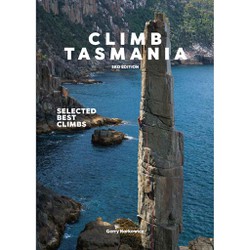Seasonality
Description
The jewel of Frenchmans Cap, this is by far the longest continuous cliffline in the area. It also contains 3 of its best routes - The Lorax (20), The Great Flake (22) and De-Gaulle's Nose (23).
For the (even) more adventurous, the inverted triangle headwall to the R of the top of Conquistador is completely unclimbed, covered with holds and is overhung for the entirety of its 70m length.
For most though it will be about conquering this mighty face - usually by the outstanding Lorax - the biggest of its kind in the country.
Access issues inherited from Frenchmans Cap Area
It's a 25km hike from the Lyell Highway.
Approach
Follow the summit track until flat ground traversing the tiers above Tahune Hut. You will find a small mound of rocks indicating you should turn around and continue up to the summit - ignore this and follow the vague path around to the left of the buttress to the L of the Tahune face. From here, descent directly across the boulder fields directly to the route of your choice.
Descent notes
Walk back from the edge of the cliff until you find the tourist track, then down it to Tahune Hut
Ethic inherited from Frenchmans Cap
Trad, but some bolts exist where trad is not possible.
Frenchmans Cap is in The Franklin - Gordon Wild Rivers National Park and subject to the Tasmanian Wilderness Heritage Area Management Plan. Climbing is addressed on pages 143-14 of the plan. Some of the presceriptions related to climbing are:
• The area will be predominantly maintained as a traditional climbing area. • The establishment or maintenance of routes that are protected primarily or exclusively using fixed anchors (i.e. ‘sport’ climbs) is generally prohibited. • Existing routes in the 2013 minor boundary extension that use fixed anchors may be maintained. New routes may be established in existing locations where fixed anchors are utilised subject to approval by PWS. • Based on historical precedence, the occasional limited installation (or replacement) of permanent anchors at Mt Geryon, The Acropolis, Frenchmans Cap and Mt Anne is permitted. • Written authority must be obtained from the PWS before using power-driven equipment to install or replace any permanent anchor in the TWWHA.
Tags
Plan your Trip
Did you know?
Did you know that you can create an account to record, track and share your climbing ascents? Thousands of climbers are already doing this.
Selected Guidebooks more Hide
Author(s): Gerry Narkowicz
Date: 2021
ISBN: 9780646841946
Cracks, sea stacks, big walls, remote exotic locations, volcanic columns, no crowds and your choice of the predominant dolerite, some quartzite and a little sandstone to remind you of the mainland. Many a wilderness climbing experience can be had within a 2hr car trip from the main centers. By Gerry Narkowicz. This guide features 1280 routes.
Accommodations nearby more Hide
Share this
Photos Browse all photos

David Tan on ★★★ The Lorax 20 - PANO_20181231_145919.jpg
/a3/a1/a3a1f78983a88882bee302e08bd3863c83881af7)
Tom Scott and Harley Mills on ★★ The Ninth of January 19 - 20230105_103955.jpg

David Tan on ★★★ The Lorax 20 - PANO_20181231_122336.jpg
/1e/41/1e41210a4eac457f7fc53c2053ac7f68ab49ec3e)
Tom Scott and Harley Mills on ★★ The Ninth of January 19 - 20230105_115535.jpg
Get a detailed insight with a timeline showing
- Ticks by climbers like you
- Discussions of the community
- Updates to the index by our users
- and many more things.
Login to see the timeline!

